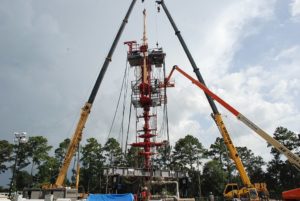SNUBBING OPERATIONS #
Snubbing is one of the older intervention methods around — but that doesn’t mean it isn’t still a highly relevant tactic. Modern technology means snubbing operations continues to be a viable option, especially when your team is faced with a pressurized well. This intervention method has stood the test of time because of some of the clear advantages it presents. So here are some of the basics you should understand about snubbing operations.
What are snubbing operations? #

Courtesy: Wikipedia
Snubbing forces drillpipes into the wellbore when there is pressure contained in the well. In short, the well is under pressure and snubbing ensures that drillers are able to isolate, stabilize and control that pressure.
Too much pressure can make conventional well operations difficult to execute. This pressure can create a level of force capable of overcoming a drillstring and forcing it out of the wellbore. To prevent this, snubbing units push that string back into the wellbore using a sophisticated hydraulic system. Because snubbing is a complex process, it requires extensive pre-planning and the appropriate collection of equipment.
Snubbing units can vary in terms of strength, with certain units able to pull at a higher rate and efficiency.
When is this method used? #
Snubbing operations are used in pressurized well situations when lighter, less-involved drilling interventions have been attempted and proven unable to work. Because snubbing can present risks, this method is usually used only when absolutely necessary.
Conceived in the 1920’s, snubbing initially arose as a solution to emergency situations, like an uncontrolled well or a blowout.
What are the advantages and disadvantages of snubbing operations? #
Like any intervention process, skilled personnel must be performing the job to ensure all goes smoothly. When all goes smoothly, snubbing can help teams stabilize a live well and control the intervention process. If tubular members need to be pushed into a pressurized well, snubbing units are an affordable option. These units are also small, easy to transport, and fairly simple to work with after proper training. And snubbing also enables you to use larger diameter tubular processes, which means you can get better flow capacity.
A disadvantage of snubbing is the time that can go into it. Pre-planning and preparing the drillstring in these operations can be complicated and time-consuming. And because the snubbing process is complex, there are many opportunities for things to go wrong. After all, a pressurized well can present certain hazards, so the team working on it must be prepared for anything.
Learn more about Katch Kan line of products for workover.




